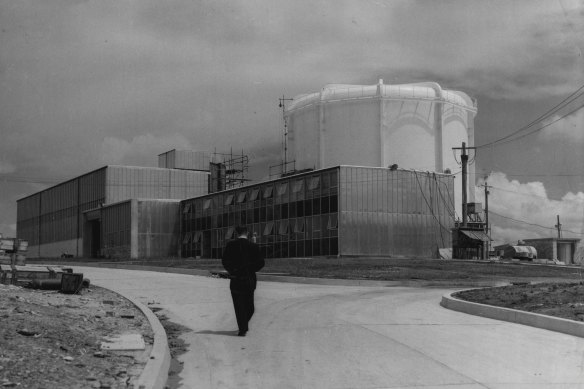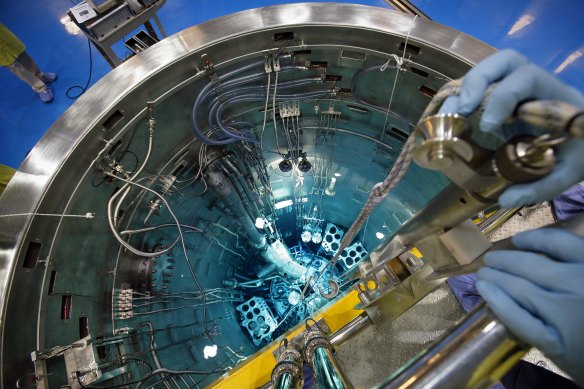Save articles for later
Add articles to your saved list and come back to them any time.
Hundreds of millions of dollars will be spent building a new radioactive medicine factory at the Lucas Heights nuclear reactor in Sydney, replacing an ageing and accident-prone facility.
The new manufacturing centre will produce the radioactive drugs doctors use to image the heart, lungs, kidney and brain for diagnosing and tracing diseases such as cancer. The current facility has been plagued by safety breaches, including in 2017, when a worker suffered radiation burns.
The nuclear reactor at Lucas Heights in 1958, a year before Building 23 was built.Credit: Archive
The government has been tight-lipped on costs ahead of a competitive tender process, but equivalent facilities in other countries have often come with price tags exceeding $400 million. The factory is expected to open in the mid-2030s.
“ANSTO’s [the Australian Nuclear Science and Technology Organisation] nuclear medicine precinct in Sydney will revolutionise the domestic production of nuclear medicines and improve the lives of thousands of Australians,” said Science Minister Ed Husic.
The facility will replace Lucas Heights’ trouble-plagued Building 23, built in 1959 as a research laboratory and later repurposed to make nuclear medicine.
Building 23 recorded seven “events with safety implications” in 2017 and 2018.
The worst of these occurred in 2017, when a worker dropped a vial of radioactive Molybdenum-99, covering their hands in the liquid.
Despite wearing two pairs of gloves, the worker suffered radiation burns and blistering.
ANSTO, which operates Lucas Heights, initially estimated the worker had been exposed to a mild dose of radiation. But an investigation by the radiation safety regulator determined the dose could have been 40 times higher than the legal annual radiation exposure limit.
The Australian Radiation Protection and Nuclear Safety Agency was so concerned, it issued a direction notice to ANSTO demanding an independent review of radiation safety in 2018, noting seven separate safety incidents within two years.
“Building 23 was designed and built in the 1950s and is scheduled to reach its end of life by the end of the 2030s,” said Ian Martin, ANSTO’s general manager of nuclear medicine. “It [has] served Australia very well, I think. But it’s an ageing facility that this [new] facility will replace.”
Like the current facility, the new one will assemble and test nuclear medical products, particularly Molybdenum-99, or Mo-99.
ANSTO is a major supplier of Mo-99, a radioactive substance that naturally decays to form Technetium-99m (Tc-99m), the workhorse of nuclear medicine. The organisation supplies about 12,000 doses a week, shipping them to facilities across Australia and the region.
Tc-99m can be used as a radioactive dye. Doctors inject it, allow it to accumulate in target organs or tissues, and then image the radiation it releases using special cameras. Tc-99m is particularly useful because it exposes patients to only a low dose of radiation.
To make Mo-99, plates of uranium are inserted into the Lucas Heights nuclear reactor, known as OPAL, which stands for open-pool Australian lightwater reactor.
The OPAL nuclear reactor at Lucas Heights.
Neutrons from the chain reaction in OPAL hit the plates, causing the uranium atoms to fragment. A small portion of those fragments are Mo-99.
The plates are then dissolved using chemicals, and the Mo-99 is extracted and purified.
The Mo-99 is then placed inside a technetium generator, an alumina tube about the width of a pencil, wrapped in radiation shielding. The Mo-99 decays slowly into Tc-99m, which can be extracted from the generator using salt water; the combined radioactive dye can then be used on patients.
A new facility was initially flagged by the former Coalition government in 2021, when $30 million was allocated for design and planning.
Liam Mannix’s Examine newsletter explains and analyses science with a rigorous focus on the evidence. Sign up to get it each week.
Most Viewed in National
From our partners
Source: Read Full Article




